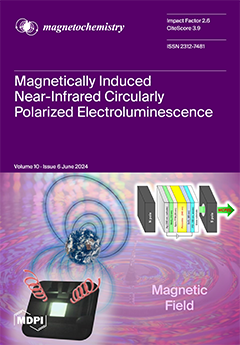The branched complexes of Schiff bases with various iron(III) salts, named G2-[L
2Fe]
+A
− (A
− is NO
3−, Cl
−, PF
6−), were synthesized using the condensation reaction between carbazole derivatives of salicylic aldehyde
[...] Read more.
The branched complexes of Schiff bases with various iron(III) salts, named G2-[L
2Fe]
+A
− (A
− is NO
3−, Cl
−, PF
6−), were synthesized using the condensation reaction between carbazole derivatives of salicylic aldehyde and N’-ethylethylenediamine and characterized by various spectroscopic methods (GPC, IR,
1H NMR, UV/Vis). The studies revealed that the coordination of the two ligand molecules to metal occurs through the nitrogen ions and oxygen atom of azomethine to form a homoleptic system. All the synthesized coordination compounds were examined for their thermal, optical, and magnetic features. Static magnetic measurements showed that only G2-[L
2Fe]Cl was in a single-phase HS state, whereas the Fe(III) ions of G2-[L
2Fe]NO
3 and G2-[L
2Fe]PF
6 at room temperatures were in mixed low-spin (LS,
S = 1/2) and high-spin (HS,
S = 5/2) states: 58.9% LS/41.1% HS for G2-[L
2Fe]NO
3, 56.1% LS and 43.9% HS for G2-[L
2Fe]PF
6. All G2-[L
2Fe]
+A
− complexes demonstrate antiferromagnetic exchange interactions between neighboring Fe(III) ions. The ground spin state at 2.0 K revealed a Brillouin contribution from non-interacting LS ions and a proportion of the HS Fe(III) ions not participating in AFM interactions: 57%, 18%, and 16% for G2-[L
2Fe]Cl, G2-[L
2Fe]NO
3 and G2-[L
2Fe]PF
6, respectively. EPR measurements confirmed the presence of magnetically active HS and LS states of Fe(III) ions and made it possible to distinguish two HS types-with strong low-symmetry (I-type) and weak, distorted octahedral environments (II-type). It was shown that G2-[L
2Fe]
+A
− complexes are magnetically inhomogeneous and consist of two magnetic sub-lattices: AFM-correlated chains in layers from the I-type HS Fe(III) centers and dynamic short-range AFM ordered LS/II-type HS Fe(III) centers in the paramagnetic phase located between the layers.
Full article





